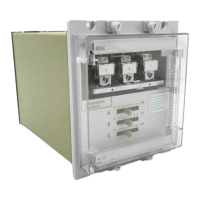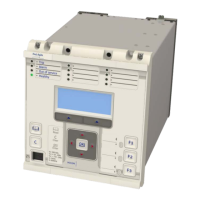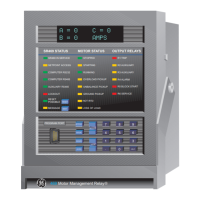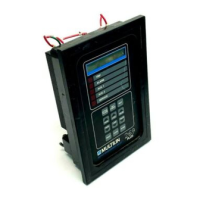Service Manual
R8010RB
MVAX Page 9/24
Relay V. rating 24/27 30/34 48/54 110/125 220/250
Ref. V. for tolerance 27 34 48 110 220
Hand reset
flag
Full volts
(no ext. R)
Full volts
(no ext. R)
35.3 – 38.8 29.1 – 36.3 24.9 – 32.5
Test 1
(Alarm
supply)
Self reset
flag
Full volts
(no ext. R)
Full volts
(no ext. R)
37.1 – 40.4 38.2 – 46.6 28.5 – 37.0
Hand reset
flag
15.0 – 17.0 18.0 – 20.5 25.8 – 29.8 53.6 – 61.2 107.0 – 120.9
Test 2
(Trip
supply)
Self reset
flag
12.0 – 14.0 18.0 – 20.5 25.8 – 29.8 53.6 – 61.2 107.0 – 120.9
Table 1
2.7.4 MVAX 31 (MVAX 91 – 3 separate MVAX 31’s in a size 8 case)
The following tests assume trip and alarm battery voltages are equal to the maximum
voltage of the relay’s voltage rating
range. For other voltages within the relay’s normal
voltage rating range, tolerance bands for other measured supply voltages should be altered
pro-rata. A table (Table 2) of acceptable tolerances for each test is given below.
Measure the trip supply and alarm supply voltages immediately prior to the tests and note.
Test
s 1 and 2
With the circuit breaker open, check the voltage acro
ss terminals 13(+) and 14(–ve) of the
relay. This should comply with the voltage tolerance limited given in Table 2. Repeat for
terminals 21(+) and 22(–ve) of the relay. The same voltage limits apply. Both these voltages
are derived from the trip supply.
Check the voltage across terminals 27(+) and 28(–ve) of the rela
y. This should be within the
limits given in Table 2 for the alarm supply. Note that the front relay unit RL1 is picked-up
and reset its flag.
Test 3
With the circuit breaker closed check that the front relay RL1, remains operated. Check that
no voltage appears
across terminals 21 and 22 of the relay. Ensure the voltage across
terminals 13(+) and 14(–ve) has increased from that obtained in Test 1 to that indicated in
Table 2.
Test 4
With the circuit breaker closed, as in test 3 above, check that the voltage between terminals
14(+) and 2
2(–ve) is zero. Measure the resistance between terminals 14 and 22 which
should comply within ±10% of the values given in Table 2. (Note: This test check that
contact 52–b is open in the breaker closed condition).
Test 5
With the circuit breaker closed, as above, apply a temporary sh
ort circuit across R
EXT
2* of
the trip supply circuit. Ensure the CB does not trip. Remove the short circuit and re-apply it
across terminals 13 and 14 of the relay. Check that RL1 drops off to initiate alarm circuits
and that RL1 flag indication is given. Remove the short circuit and reset the flag/alarms.
*Note: Where 2 resistors are used in series for R
EXT
2, a temporary short
circuit should be applied across each resistor in turn.
